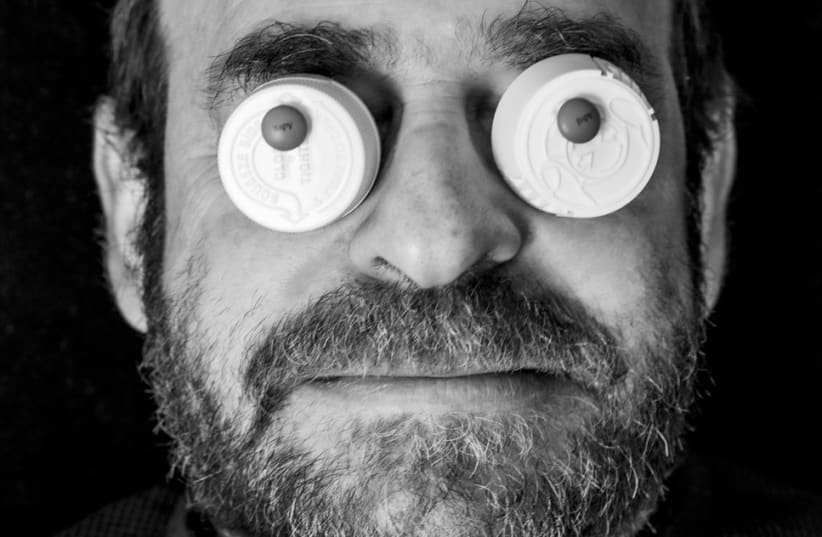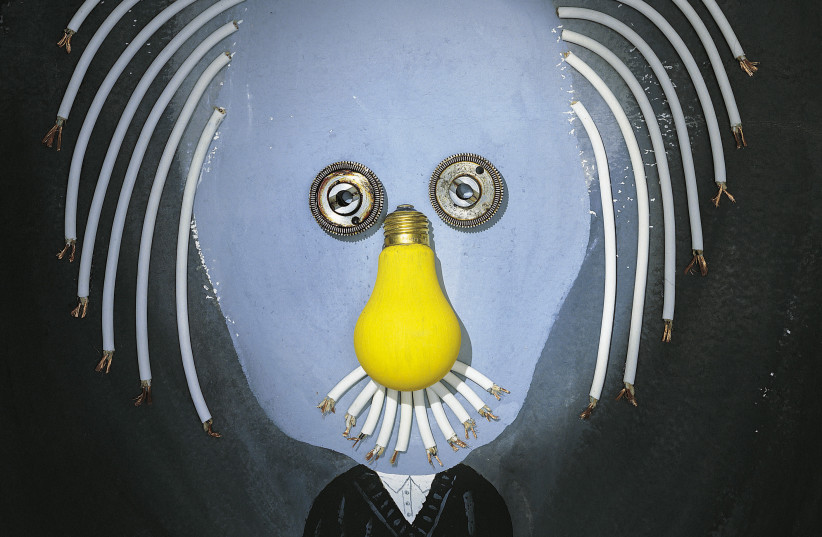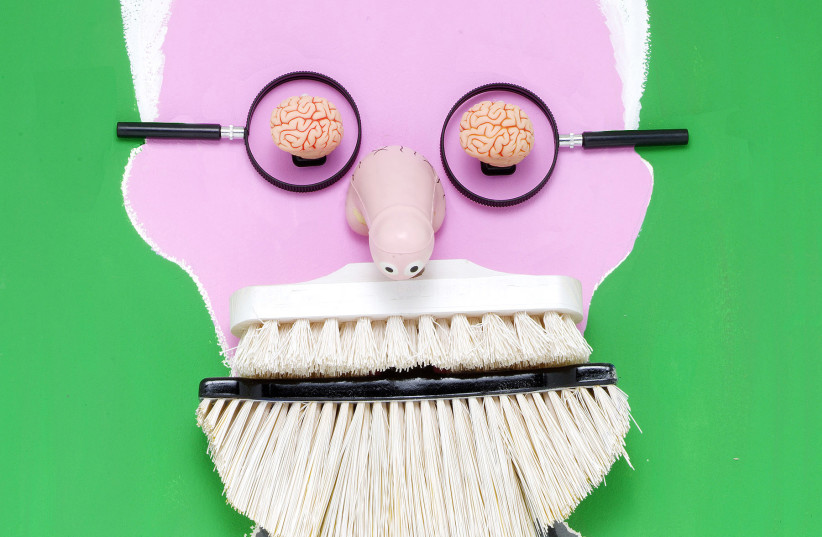His unique portraits appear in magazines across the globe, as well as in books he has authored for children and adults alike. The characteristic of his portraits is their unique use of everyday objects instead of the classical method of paint, pencil or charcoal to create the image. Who else but Hanoch Piven can use a cucumber, a light bulb, a microphone or a banana to describe a nose, or matches to represent a mustache, or slices of sausage or bread to indicate the texture of a face, or matza to show the redeemer of the Israelites from ancient Egypt?
Despite this style having brought him international fame, Piven is quite modest about his achievements: “This creation,” he told the Jerusalem Report “is designed to hide my shortcomings and embellish my talents.” His ‘shortcomings’ are a lack of ability at drawing. This may have been a reason for his being rejected from the Bezalel School of Art, when he applied to study after leaving the army.
“I was always interested in caricatures, sort of standing on the side and seeing things from an angle. When it came to going to college, I wanted to learn to draw cartoons. In 1987 at Bezalel, if you wanted to be a cartoonist or an illustrator, you needed to study graphic design. Within the graphic design department, illustrators were considered less successful as artists. Nowadays, things have changed. There is a big illustration department there that includes leading illustrators on their staff like Kishka and Uri Fink.”
His being refused by the prestigious school seems to have been one of the ‘happy accidents’ that have followed him throughout his professional life.
“As a result of being rejected from Bezalel,” he recalls, “I went to New York’s School of Visual Art. They had a great cartoon department. Mind you, while there, I moved from the cartoon department to the illustration department and eventually from there to the graphic design department. Part of these moves was motivated by the fear of not being able to get a job and make a living. I was older than the average student. I was paying a lot for the college, and I felt I was not a great draftsman. This, plus my Polish-Jewish mother nudging me continuously by saying: ‘What will become of you?’
“Studying graphic design really expanded my vocabulary, understanding visual communication, and the different elements you can introduce into your art. Suddenly, it wasn’t about technique anymore. I had to find the most efficient and interesting way of communicating something. Art school in New York was very good for me. All my teachers were famous illustrators at the time. School lasted four years and I lived in New York for 10 years. Although I eventually returned to Israel (with an American wife), I feel I am a professional product of New York.”
Reflecting on his time there, Pavin points to his influences and how he came upon his own unique style:
“I was part of that New York group of illustrators and cartoonists who in the main were emigrants from East Europe. I felt I was connected to an East European sensibility in New York. Lots of the tradition of American illustration comes from Eastern European emigrants, starting with Saul Steinberg (born in Bucharest). Lots of them were using collage, mixing objects and drawings and enhancing an object by drawing something around it. It becomes the essence of the piece. This attracted me very much. But it was also just plain luck that I stumbled on the idea.
“I was in school and studying graphic design and simultaneously taking private lessons with a cartooning teacher who used to draw for Mad magazine. Around the time of the first Gulf War I developed the idea of the collage caricature with a portrait of Saddam Hussein. I had a girlfriend who used to smoke a lot. One day I took a row of her matches and stuck them under my drawing of Hussein’s nose to represent his mustache. It seemed to characterize the man. It worked. Another happy accident!”
Although his lifelong passion had been to draw faces, he fell in love with this particular technique and all that came with it. Soon after he began making a series of portraits using objects glued onto the paper.
“This was not influenced by my private teacher at all. For Mad magazine, my teacher would draw cartoons, quite the opposite of what I was doing.”
While still at art school, Piven went to see the art director of the New York Times, Stephen Heller, who was famous among illustrators.
“He would see everyone. He would say to whoever wanted to see him: ‘Come tomorrow at 6:15 in the morning or 7:10.’ He would spend 10 minutes with you, and if your portfolio was half-decent, he would usually say: ‘OK, I want to commission you.’ He was famous for giving illustrators their first job.
“When I came to see him he looked quickly at my work. I was in my third year at school, right after I had made this first series of three-dimensional portraits. He kept saying ‘nice, nice nice,’ and then he said: ‘I’m curating a book of American caricatures and I would like to include a couple of your pieces in my book.’ This book came out and was very influential. It was the art of contemporary caricature. All the ‘greats’ were in it, David Levine, Ralph Steadman, the illustrators for Spitting Image – all my heroes.
“After the book came out magazines started to call me. Rolling Stone, Time – the big magazines. This was the beginning of my career. I soon established myself as an editorial illustrator. I had an agent. I stayed in New York for another four years before I came back to Israel. I already had a name. But I also understood that I could do these illustrations at a distance. I didn’t need to be in New York.”
Pavin’s travels began somewhat earlier. Born in Montevideo, Uruguay, his family immigrated to Israel in 1975 when he was 11.
“We came to Ramat Gan” he recalls. “I was just trying to survive as a new immigrant. In Israel, there were certain ways that you had to be in order to survive. There was less diversity back then. In the ’70s in Israel, you had to be a tough guy and so forth.” Slight of build and with his artistic leanings, he could never quite fit this profile. No wonder that he observes: “I really became myself only when I went to New York. In a way, I needed to be in a large place that allowed for many different ways of being.”
In Israel he felt that he was a sort of stranger, an outsider. He didn’t have anyone in the family who was an artist. His father was a dentist, and his mother a social worker. So everything he did was as an individual. Once he had found his particular style, he was on his way.
“This technique allowed the humorous side of me to emerge. I may not be a good draftsman, but I understand what it is that makes your face look like it does. I have a better eye than a hand. I see better than I can draw. I felt that this was a way of getting around that limitation. In addition, I always loved colors and color combinations. That emerges along with my sense of humor. The elements that comprise my work are humor, color, an understanding of the face, and the ability to communicate.”
Although he claims that his illustrations are “‘beyond language” and stand on their own, he is very open to their interpretation by others. “I don’t like to explain the objects exactly because it goes beyond what I could explain.”
“Take my portrait of president Obama – I made his nose from a toy Aladdin’s lamp. This is the type of object that I like because it has so many interpretations. Obama came from another place, mysterious, eastern. His is a kind of fairy tale story. When I give classes to kids and ask them why do you think that nose is there, I get many different answers. A lot of people thought that Obama is a Moslem. So they would see that Aladdin lamp and say immediately: ‘Of course, because he’s a Muslim.’
“Once a kid in Boston said, ‘I know why you put that there. It is a tea kettle, and when the water boils the leaves fly away, and that symbolizes freedom.’ That’s the beauty of these objects. They manage to open up a space within the head of the viewer. They bring him into their own world and it resonates with them. This is where an object goes beyond itself. It doesn’t always happen, but when it does it’s really nice. They generate connotations that were not intended.”
In a similar way, Piven placed a toy broom to indicate Sarah Netanyahu’s hair.
“In Italy, a broom is an item that is associated with fascism. The origin of the word is a bundle of sticks tied together. When someone pointed that out, he was convinced that it is what I thought of when I put it in! That is like a little present that made me think deeper into my work and into what I do. It helps when I ask myself what is the purpose of my work?
“These associations are sort of Freudian. I’m a deep believer that when you do art, or when you are exposed to art, you are in a different space, one that allows you to think for yourself. You come up with your own ideas and interpretations. Just as the broom that I put in Sarah Netanyahu’s hair goes beyond words. If you spell it out in words it maybe sounds cheap, a kind of goofy metaphor. But if you just leave it there... people don’t necessarily spell it out but they get it.”
Some of his portraits are simultaneously thought-provoking and humorous. His portrait of Woody Allen, for example, shows the cinema director and actor with broken glasses suggesting the schlemiel – the character that he often plays – alongside his nose as a banana, which hints at one of his films (Bananas) as well as giving the impression that his cinema is also about fun.
Similarly, his portrait of Barbra Streisand with her nose as a microphone shows off her incredible ability as a singer while simultaneously suggesting that her natural nose is a little too big for her face. President Trump is portrayed as having a banana in place of his hair, suggesting perhaps of the number of slips he made in his career as president.
Piven articulates his philosophy in a way that links his art intimately to his life:
“As an artist, you are in a constant dialogue with yourself. You experience failure, frustration, try again, excitement... this is what you need. You grow as a person if you grow as an artist. I feel that art is a vehicle. Having been doing this for 30 years, using my resources to make a living and support a family, to send my kids to college, to be able to maintain another apartment in Spain, which is where my wife is. I have to reflect that all this comes from these ‘toys.’ Its about being resourceful. I feel this was the main tool for my growth.”
At one point in our interview Piven goes over to a largish set of open shelves and enthusiastically points to his ‘toy’ collection:
“This is only a third of my collection,” he says. “I throw away many items, especially when I move. These are the best of the best.” Each of the plastic boxes contains a particular group of items. He enumerates them one by one:
“These are tools, those are learning stuff, wisdom or thinking, knowledge. This box represents transportation, such as cars. This next one is medicine, that is body parts, games, plumbing, anything to do with Israel, parties, nature, food, animals, etc.” Laughing as he displays his varied collection of miniatures, he tries to summarize: “I tried to have some sort of order within the mess.”
When he returned to Israel in 1995, he had with him a portfolio of two or three years of published work that he had done in America. He did the rounds showing his work, eventually meeting with the editor of the weekend supplement of Haaretz.
“We really hit it off,” he recalls. “He asked me to start a weekly column, which I was confident enough to say that I could not commit to more than once a month. It takes me a long time to make one portrait.
“I both wrote and did the design. Alongside that, I was doing a lot more illustrations for other magazines. It was a sort of golden age of illustrations for American magazines. I also worked for the Ma’ariv newspaper, and for educational TV, in the program Hop. In addition, I created a number of children’s books, and a book on PMs of Israel. Right now I’m finishing a book on 14 biblical characters that will come out in the USA, and is intended to provide an entry point for students into the Bible.
“I also taught at the Shenkar School of design and later, ironically enough, at Bezalel for four years. These were my first years of teaching and I loved it. But in 2001 we moved the family. My wife and I decided we would try to live a couple of years in Europe. We moved to Barcelona, and since then the center of the family has been in Barcelona. Ten years later I came back to Israel by myself, and in the last 10 years, I have had my studio here in this apartment. Before Covid I was traveling maybe 20 times a year, commuting to and from work. We liked Barcelona before it became popular. I speak Spanish – I was born in South America. My wife also speaks some Spanish. It just felt right for us. Our children were brought up partially in Barcelona, although now they are both in the USA. My wife is in Barcelona where she paints.
“For the past 20 years, I’ve been teaching freelance all over the world. One thing which became very important to me is teaching non-artists. I help them communicate visually, non-verbally. Providing them with a language in which it is easy to use means that there is no technical barrier. In a way it duplicates what happened to me, telling people that they don’t need to worry about not being able to draw. This was a whole new way of thinking for me.
“I have witnessed the benefits that art can bring to people. It has brought me to apply art to different areas – education, therapy, organizational consultation, company consulting, art schools. I have a team of educators who work with me and we do many workshops throughout Israel and abroad. We visit schools. We do self-portraits in seventh grade when are studying roots. We do self-portraits together with their families. We have even done special projects with 11th- and 12th-graders preparing for matriculation.
“Although I accept private commissions, for example for someone’s birthday, I don’t sell my art as an artist. Mainly I work for magazines. A good part of my income comes from teaching. I am very happy that I have this side of my work. It is better than being dependent on producing the whole time, where you have to deliver and be at your best.”
One last thought. Among those ‘victims’ of his sharp art are a number of people who asked for the originals. One was Jakob Dylan, who asked for the portrait of his dad, Bob. Another was Howard Stern, who wanted to use it in his own book. Neither Woody Allen nor Barbra Streisand were in contact.■


